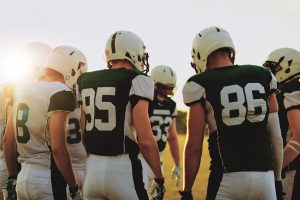Tis the Season for Football Turf Toe: What to Understand About this Injury
 Turf toe is common among American football players that affects the big toe joint. Frequently pushing off with the toes in a sprint or making sudden movements while running is often the culprit of causing this painful condition. Dealing with this injury is not only painful, but it can also cause damage to the bones and soft tissues within the foot. If foot pain is taking you out of the game, it’s imperative to seek treatment to avoid further injury.
Turf toe is common among American football players that affects the big toe joint. Frequently pushing off with the toes in a sprint or making sudden movements while running is often the culprit of causing this painful condition. Dealing with this injury is not only painful, but it can also cause damage to the bones and soft tissues within the foot. If foot pain is taking you out of the game, it’s imperative to seek treatment to avoid further injury.
At Orthopaedic Hospital of Wisconsin, we want you to play and feel your best. OHOW physical therapist, David Tranchita, PT, DPT, OCS, CMTPT, CSCS, has over 30 years of experience in orthopedic physical therapy. Below he explains this common condition, diagnosis, and treatment options.
What Causes Turf Toe?

A turf toe injury happens when the big toe is bent at a 90-degree angle and pressed forcefully against the ground. Usually, the heel is high off the ground, like a sprinter’s block starting position in track or a three-point stance in football. When you put too much force on the big toe, you can hyperextend the toe (bend it farther than it’s supposed to go). This bending of the toe beyond its natural range of motion can cause injury to the tissues around the big toe joint and tear or sprain the ligaments. It also strains the soft tissues of that foot.
Turf toe can result from many repetitive movements over time. The injury can also result from sudden trauma, such as when a football player tackles an opponent with their toe planted on the ground. Athletes who make sudden foot movements and changes in direction are more likely to get this type of injury.
Turf toe injuries increased in the 1970s when football players began playing on artificial turf instead of grass. Artificial turf is a firmer surface than natural grass and has less give. There is also an increase in turf toe injuries over the past few years. This increase may be due to more flexible and lighter shoes and the interaction between the hard surface and the shoe itself.
What are the Symptoms of Turf Toe?
Turf toe symptoms range from mild to severe. If a sudden injury caused turf toe, you may have heard or felt a “pop” when the injury happened. Pain from a sudden injury usually comes on right away.
Turf toe symptoms from repetitive injuries usually appear gradually and get worse over time.
Symptoms of turf toe include:
- Pain and tenderness: Pain may be constant or only hurt when you press on the area. Big toe pain may be so severe that you cannot put weight on it.
- Swelling and bruising: The base of the big toe may be inflamed. Bruising can extend around the swollen toe and up to the top of the foot.
- Limited range of motion: You may not be able to move your toe or bend it up and down. You may feel like your foot is weak or you are unable to push off the ground like before.
- The joint that feels loose: The metatarsophalangeal (MTP) joint may pop out of place or feel unstable. The joint may also feel stiff.
What are the types of turf toe injuries?

Healthcare providers use a grading system to classify turf toe injuries. The grade helps determine the most effective treatment plan. The types of turf toe injuries are:
- Grade 1: Typically soft tissue is stretched but not torn. The area is sensitive when you touch it. It may be mildly swollen. You may have mild limitations with sports and exercise abilities.
- Grade 2: The soft tissue complex partially tears. The area has intense and more diffuse tenderness and is often swollen and bruised. You’ll be more limited with sports and exercises.
- Grade 3: Soft tissues are completely torn. The MTP joint may be dislocated. Swelling and pain in the toe are severe. It is difficult to move the toe, let alone exercise or play sports.
How is turf toe diagnosed?
- Your healthcare provider examines your toe and gently pushes on the area to check for tenderness. You may be asked to move your toe to test your range of motion.
- To check for bone and soft tissue damage, your provider may order an X-ray or MRI scan. These tests produce images of bones, ligaments, tendons, and soft tissues.
- If you had a sudden injury, your provider will ask you how it happened. Be sure to share as many details as you remember, including how your toe was planted and where you felt pain.
What is the treatment for turf toe?
Most sprained toe injuries heal with time and plenty of rest. Grades 1 and 2 turf toe injuries usually get better with conservative and noninvasive treatments that you can do at home. Your athletic trainer or therapist may recommend:
- Rest: Ask your provider how long you should avoid putting weight on your foot. Depending on the severity of the injury, you may need to take a break from sports and activities for several days or weeks. Your provider can give you a walking boot or crutches while your toe heals.
- Ice and elevation: Relax with your foot above your heart every few hours. Apply a cold compress to your toe for about 20 minutes. Ice reduces swelling and pain. Elevating your toe reduces inflammation.
- Over-the-counter pain medication: Talk to your physician about taking nonsteroidal anti-inflammatory drugs (NSAIDS), such as ibuprofen, Aleve, or Advil, which relieve pain by reducing inflammation and swelling.
- Physical therapy (PT): An experienced physical therapist will give you exercises to improve range of motion, reduce stiffness, improve flexibility with stretches and strengthen muscles that support the MTP joint of the big toe
- Stabilization: Your athletic trainer and/or physical therapist will show you how to tape your big toe for support and protection. This turf toe taping technique restricts motion while your toe heals. When you do return to activities, be sure to wear sturdy, supportive footwear.
- Orthotics: Your provider may recommend special inserts that fit into your shoe. Orthotics stabilize and support your arch and toe joint while you’re running, jumping, or playing sports.
- Surgery: Rarely, a turf toe injury requires surgery to repair severe tears, fractures, or joint damage. The type of surgery depends on the injury’s location and which bones and soft tissues have the damage.
Can I prevent turf toe?
You may not always be able to prevent turf toe, especially when it results from an accident. To reduce your risk of turf toe, wear shoes that provide enough stability for your activity. Football and soccer players should avoid shoes that are too flexible, especially in the toe area.
Before an activity or sport, take time to stretch and warm up. When muscles and soft tissues are warm, they’re less likely to get injured. If you play sports that increase your risk of turf toe, talk to a physical therapist that can help you lower your chances of injury.
What is the outlook for people with turf toe?
Many people with turf toe do not have long-term problems after recovering from the injury. Some people continue to have joint stiffness, weakness, or big toe pain (hallux rigidus). Rarely, the big toe sticks up from the others and doesn’t lie flat on the floor when standing.
When should I see my healthcare provider about turf toe?
Call your healthcare provider if you have pain, swelling, or bruising in your toe or foot right after the injury. Even if the pain is mild, it’s vital to get evaluated so your provider can recommend the right treatment plan. See your provider immediatly if the pain is severe, you can’t put weight on your foot, or the toe joint looks deformed or dislocated.
A turf toe injury can put you on the sidelines for days or weeks. But with proper care and treatment, turf toe injuries usually heal without long-term problems. It’s essential to follow your physical therapist’s instructions and give your body plenty of time to heal.
If you feel pain in your big toe during sports or activities, take a break. Never ignore pain or push through it — doing so can make an injury worse. See a physical therapist quickly for an evaluation so you can get back in the game as soon as possible.
To see one of the talented physical therapists at Orthopaedic Hospital of Wisconsin, make an appointment today.

